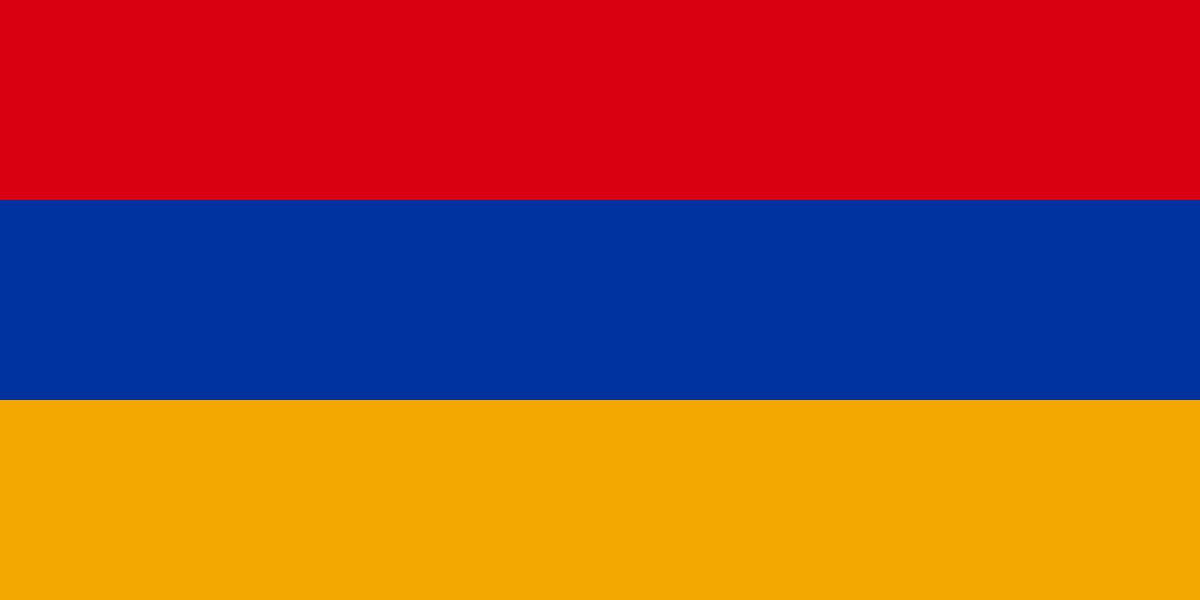The red stripe, positioned at the top, carries a profound historical weight. It stands as a testament to the indomitable spirit of the Armenian populace, an unwavering force that has endured through centuries of adversities such as invasions, oppression, and the harrowing genocide. This deep crimson hue also serves as a poignant reminder of the blood shed by Armenian martyrs who valiantly defended their homeland and cultural heritage.
Occupying the middle position, the blue stripe embodies the tranquil aspirations of the Armenian nation. It mirrors the serene expanse of the Armenian sky, a beacon of hope and serenity that envelops the land. This shade of blue symbolizes the unwavering pursuit of a brighter future, an emblem of the Armenian people's resilience and their determination to surmount challenges and cultivate a harmonious society.
The vibrant orange hue gracing the bottom stripe is an ode to Armenia's fertile terrain and the diligent toil of its inhabitants. This color pays homage to the agricultural legacy that has sustained the Armenian people for millennia, a testament to their unyielding resolve and the enduring spirit that has allowed them to thrive on their ancestral lands.
Cultural and Historical Significance:The genesis of the Armenian flag's design traces back to the early 20th century, a pivotal era when the tricolor arrangement gained prominence as a fervent emblem of Armenian independence during the establishment of the First Republic of Armenia (1918-1920).
Embedded within the flag's design are echoes of the Armenian coat of arms, a visual homage to various epochs of Armenian history. This interweaving of historical elements lends the flag a palpable connection to Armenia's multifaceted and storied past.
A unifying force, the flag galvanizes the Armenian populace both within the country's borders and across the expansive diaspora. It serves as a rallying point, an icon that fosters a profound sense of collective identity, reinforcing the shared bonds that transcend geographical distances.
Historical Antecedents:The flag's lineage, though officially recognized in 1990, can be traced to the medieval Armenian Kingdom of Cilicia, an empire that flourished from the 11th to the 14th centuries. This historical predecessor employed a similar tricolor motif, which likely played a role in shaping the modern flag's arrangement.
The utilization of the hues red, blue, and orange finds its origins in antiquity, evident in early Armenian artifacts, manuscripts, and artistic creations. These colors, woven into the fabric of Armenian heritage, bear testament to their enduring presence throughout the nation's history.
Flag Protocol and Application:The Armenian flag graces flagpoles in a myriad of settings, whether singly or harmoniously accompanied by other national flags. Its presence is most pronounced during official ceremonies, national celebrations, and events of significance, where it stands as a potent symbol of Armenian pride.
On diplomatic occasions, the Armenian flag often stands shoulder-to-shoulder with the host country's ensign or other international flags, epitomizing diplomatic amity and cooperation.
From adorning public spaces to gracing government edifices, educational institutions, and cultural hubs, the flag's resonance as a unifying emblem is further amplified. Its prominent display reinforces its role as a tangible representation of national unity.
Global Impact:For Armenians across the globe, the flag is a wellspring of pride and a beacon of hope. Its symbolism holds particular resonance within the expansive Armenian diaspora, acting as a conduit to sustain cultural connections and express unwavering solidarity with the ancestral homeland.
The flag's distinct colors and design have endowed it with international recognition, amplifying the sense of Armenian identity on a global scale. This recognition facilitates cross-cultural exchanges, engendering awareness and understanding of Armenia's rich heritage.
In its essence, the Armenian flag transcends its visual manifestation; it encapsulates the very essence and ethos of the Armenian people. It embodies their historical narrative, their struggles and aspirations, and the unbreakable thread that binds them together across the annals of time and geographical borders.
Last Updated on: November 13, 2025
